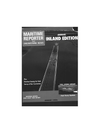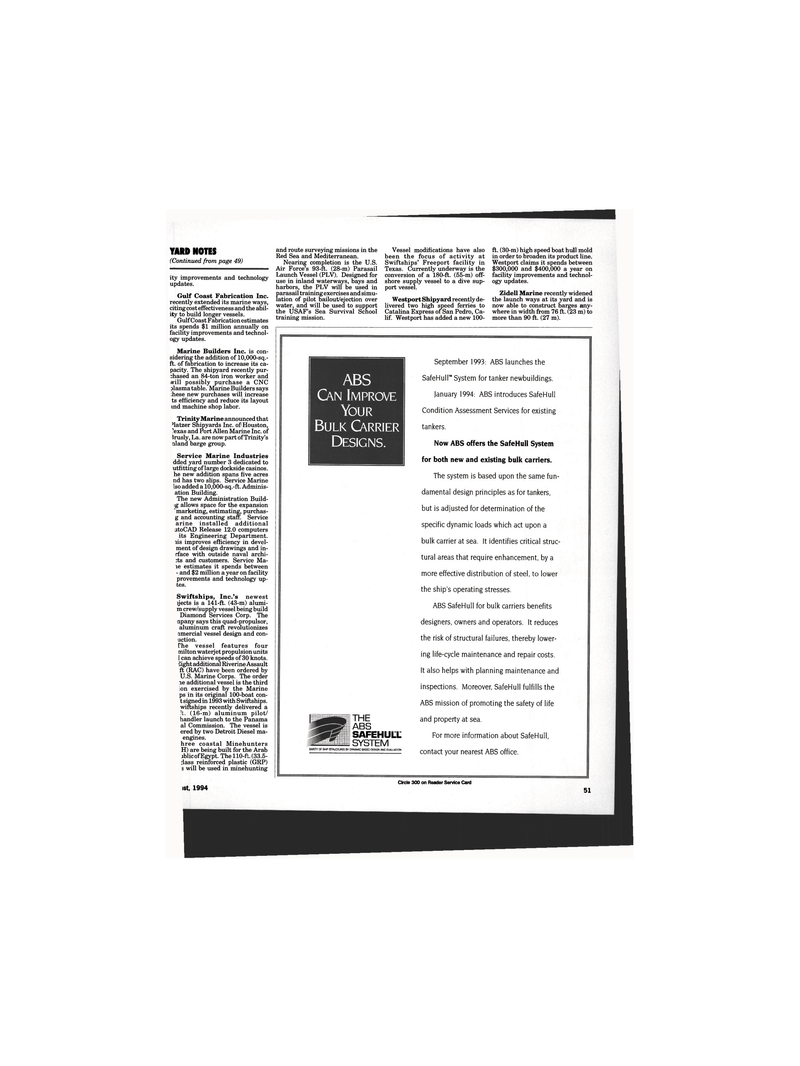
Page 71: of Maritime Reporter Magazine (August 1994)
Read this page in Pdf, Flash or Html5 edition of August 1994 Maritime Reporter Magazine
YARD NOTES (Continued from page 49) ity improvements and technology updates.
Gulf Coast Fabrication Inc. recently extended its marine ways, citing cost effectiveness and the abil- ity to build longer vessels.
Gulf Coast Fabrication estimates its spends $1 million annually on facility improvements and technol- ogy updates.
Marine Builders Inc. is con- sidering the addition of 10,000-sq.- ft. of fabrication to increase its ca- pacity. The shipyard recently pur- chased an 84-ton iron worker and will possibly purchase a CNC plasma table. Marine Builders says ;hese new purchases will increase ts efficiency and reduce its layout ind machine shop labor.
Trinity Marine announced that 'latzer Shipyards Inc. of Houston, ^exas and Port Allen Marine Inc. of $rusly, La. are now part of Trinity's aland barge group.
Service Marine Industries dded yard number 3 dedicated to utfitting of large dockside casinos, he new addition spans five acres nd has two slips. Service Marine
Iso added a 10,000-sq.-ft. Adminis- ation Building.
The new Administration Build- ig allows space for the expansion 'marketing, estimating, purchas- g and accounting staff. Service arine installed additional utoCAD Release 12.0 computers its Engineering Department, lis improves efficiency in devel- ment of design drawings and in- rface with outside naval archi- es and customers. Service Ma- le estimates it spends between - and $2 million a year on facility provements and technology up- tes.
Swiftships, Inc.'s newest )jects is a 141-ft. (43-m) alumi- m crew/supply vessel being build
Diamond Services Corp. The tipany says this quad-propulsor, aluminum craft revolutionizes imercial vessel design and con- action.
The vessel features four milton wateijet propulsion units
I can achieve speeds of 30 knots.
Sight additional Riverine Assault ft (RAC) have been ordered by
U.S. Marine Corps. The order le additional vessel is the third ion exercised by the Marine ps in its original 100-boat con- t signed in 1993 with Swiftships. wiftships recently delivered a (16-m) aluminum pilot/ handler launch to the Panama al Commission. The vessel is ered by two Detroit Diesel ma- engines. hree coastal Minehunters
H) are being built for the Arab lblic of Egypt. The 110-fit. (33.5- ;lass reinforced plastic (GRP) 3 will be used in minehunting and route surveying missions in the
Red Sea and Mediterranean.
Nearing completion is the U.S.
Air Force's 93-ft. (28-m) Parasail
Launch Vessel (PLV). Designed for use in inland waterways, bays and harbors, the PLV will be used in parasail training exercises and simu- lation of pilot bailout/ejection over water, and will be used to support the USAF's Sea Survival School training mission.
Vessel modifications have also been the focus of activity at
Swiftships' Freeport facility in
Texas. Currently underway is the conversion of a 180-ft. (55-m) off- shore supply vessel to a dive sup- port vessel.
Westport Shipyard recently de- livered two high speed ferries to
Catalina Express of San Pedro, Ca- lif. Westport has added a new 100- ft. (30-m) high speed boat hull mold in order to broaden its product line.
Westport claims it spends between $300,000 and $400,000 a year on facility improvements and technol- ogy updates.
Zidell Marine recently widened the launch ways at its yard and is now able to construct barges any- where in width from 76 ft. (23 m) to more than 90 ft. (27 m).
ABS
CAN IMPROVE
YOUR
BULK CARRIER
DESIGNS.
THE
ABS
SAFEHULL
SYSTEM
SAFETY OF SHIP STRUCTURES BY DYNAMIC BASED DESIGN AND EVALUATION
September 1993: ABS launches the
SafeHull™ System for tanker newbuildings.
January 1994: ABS introduces SafeHull
Condition Assessment Services for existing tankers.
Now ABS offers the SafeHull System for both new and existing bulk carriers.
The system is based upon the same fun- damental design principles as for tankers, but is adjusted for determination of the specific dynamic loads which act upon a bulk carrier at sea. It identifies critical struc- tural areas that require enhancement, by a more effective distribution of steel, to lower the ship's operating stresses.
ABS SafeHull for bulk carriers benefits designers, owners and operators. It reduces the risk of structural failures, thereby lower- ing life-cycle maintenance and repair costs.
It also helps with planning maintenance and inspections. Moreover, SafeHull fulfills the
ABS mission of promoting the safety of life and property at sea.
For more information about SafeHull, contact your nearest ABS office. ist, 1994
Circle 300 on Reader Service Card 51

 70
70

 72
72
